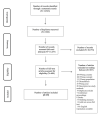Organizational Factors and Their Impact on Mental Health in Public Safety Organizations
- PMID: 36360872
- PMCID: PMC9658143
- DOI: 10.3390/ijerph192113993
Organizational Factors and Their Impact on Mental Health in Public Safety Organizations
Abstract
Public safety personnel (PSP), including correctional officers, firefighters, paramedics, and police officers, have higher rates of mental health conditions than other types of workers. This scoping review maps the impact of organizational factors on PSP mental health, reviewing applicable English language primary studies from 2000-2021. JBI methodology for scoping reviews was followed. After screening, 97 primary studies remained for analysis. Police officers (n = 48) were the most frequent population studied. Correctional officers (n = 27) and paramedics (n = 27) were the second most frequently identified population, followed by career firefighters (n = 20). Lack of supervisor support was the most frequently cited negative organizational factor (n = 23), followed by negative workplace culture (n = 21), and lack of co-worker support (n = 14). Co-worker support (n = 10) was the most frequently identified positive organizational factor, followed by supervisor support (n = 8) and positive workplace culture (n = 5). This scoping review is the first to map organizational factors and their impact on PSP mental health across public safety organizations. The results of this review can inform discussions related to organizational factors, and their relationship to operational and personal factors, to assist in considering which factors are the most impactful on mental health, and which are most amenable to change.
Keywords: first responders; occupational health; occupational stress; organizational factors; public safety.
Conflict of interest statement
The authors declare no conflict of interest.
Figures
Similar articles
-
Mental health of public safety personnel: Developing a model of operational, organizational, and personal factors in public safety organizations.Front Public Health. 2023 Mar 2;11:1140983. doi: 10.3389/fpubh.2023.1140983. eCollection 2023. Front Public Health. 2023. PMID: 36935659 Free PMC article.
-
A review of workplace mental health interventions and their implementation in public safety organizations.Int Arch Occup Environ Health. 2022 Apr;95(3):645-664. doi: 10.1007/s00420-021-01772-1. Epub 2021 Oct 10. Int Arch Occup Environ Health. 2022. PMID: 34628523 Review.
-
Applying the Theoretical Domains Framework to identify police, fire, and paramedic preferences for accessing mental health care in a First Responder Operational Stress Injury Clinic: a qualitative study.Health Promot Chronic Dis Prev Can. 2023 Nov;43(10-11):431-449. doi: 10.24095/hpcdp.43.10/11.02. Health Promot Chronic Dis Prev Can. 2023. PMID: 37991887 Free PMC article.
-
Assessing the Relative Impact of Diverse Stressors among Public Safety Personnel.Int J Environ Res Public Health. 2020 Feb 14;17(4):1234. doi: 10.3390/ijerph17041234. Int J Environ Res Public Health. 2020. PMID: 32075062 Free PMC article.
-
Compromised Conscience: A Scoping Review of Moral Injury Among Firefighters, Paramedics, and Police Officers.Front Psychol. 2021 Mar 31;12:639781. doi: 10.3389/fpsyg.2021.639781. eCollection 2021. Front Psychol. 2021. PMID: 33868111 Free PMC article.
Cited by
-
Physiological Responses to Organizational Stressors Among Police Managers.Appl Psychophysiol Biofeedback. 2024 Mar;49(1):85-102. doi: 10.1007/s10484-023-09613-2. Epub 2024 Jan 20. Appl Psychophysiol Biofeedback. 2024. PMID: 38244109 Free PMC article.
-
Mental health of public safety personnel: Developing a model of operational, organizational, and personal factors in public safety organizations.Front Public Health. 2023 Mar 2;11:1140983. doi: 10.3389/fpubh.2023.1140983. eCollection 2023. Front Public Health. 2023. PMID: 36935659 Free PMC article.
-
Stress among police officials in Kerala, India: an analysis of organizational and operational factors.BMC Psychol. 2025 May 16;13(1):512. doi: 10.1186/s40359-025-02831-9. BMC Psychol. 2025. PMID: 40380270 Free PMC article.
-
Perspectives and Experiences of Public Safety Personnel Engaged in a Peer-Led Workplace Reintegration Program Post Critical Incident or Operational Stress Injury: A Qualitative Thematic Analysis.Int J Environ Res Public Health. 2024 Jul 19;21(7):949. doi: 10.3390/ijerph21070949. Int J Environ Res Public Health. 2024. PMID: 39063525 Free PMC article.
-
Posttraumatic stress disorder and depression after the 2018 Strasbourg Christmas Market terrorist attack: a comparison of exposed and non-exposed police personnel.Eur J Psychotraumatol. 2023;14(2):2214872. doi: 10.1080/20008066.2023.2214872. Eur J Psychotraumatol. 2023. PMID: 37305952 Free PMC article.
References
-
- CIPSRT Glossary of Terms: A Shared Understanding of the Common Terms Used to Describe Psychological Trauma (Version 2.1) [(accessed on 13 October 2022)]. Available online: https://www.cipsrt-icrtsp.ca/en/resources/glossary-of-terms.
-
- Carleton R.N., Afifi T.O., Taillieu T., Turner S., Mason J.E., Ricciardelli R., McCreary D.R., Vaughan A.D., Anderson G.S., Krakauer R.L., et al. Assessing the relative impact of diverse stressors among public safety personnel. Int. J. Environ. Res. Public Health. 2020;17:1234. doi: 10.3390/ijerph17041234. - DOI - PMC - PubMed
Publication types
MeSH terms
LinkOut - more resources
Full Text Sources
Medical
Miscellaneous


